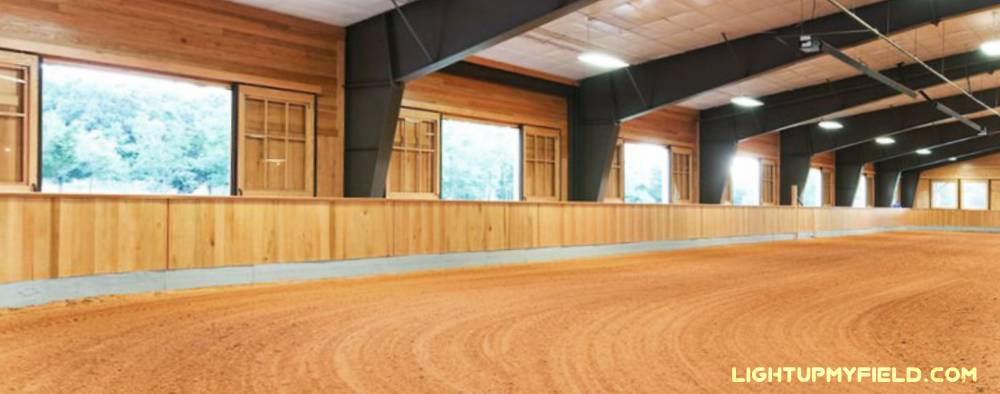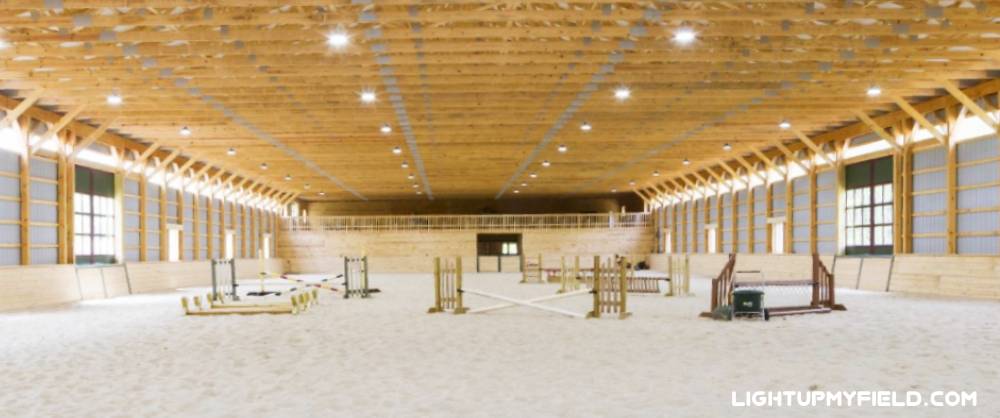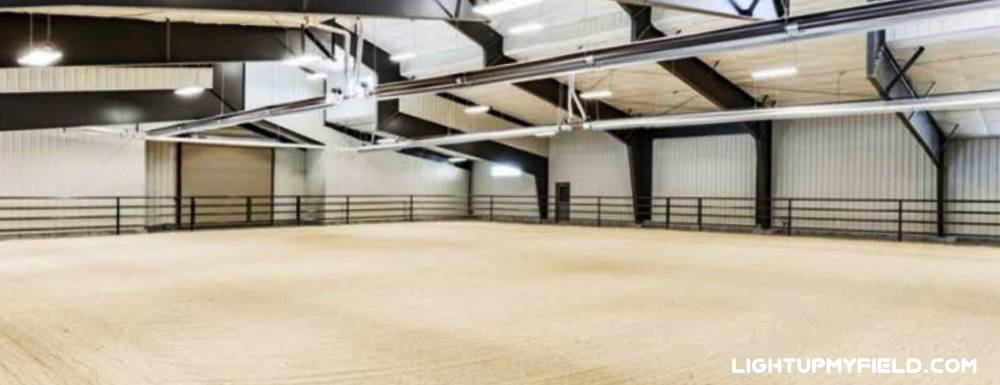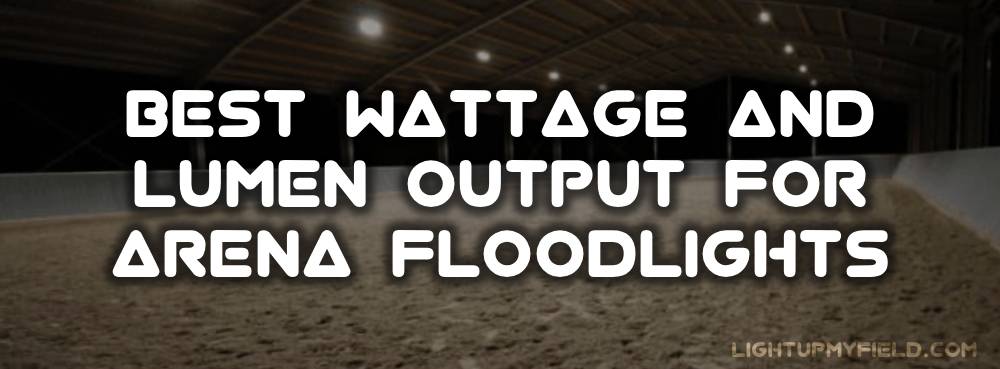If you’ve ever thought about lighting up a horse arena, you probably wondered what wattage or lumen count would do the trick. Getting the right balance isn’t just about grabbing the brightest or biggest light you can find. It’s about understanding what wattage and lumens actually mean and how they affect the way your arena looks and feels at night. So, how do you pick the right floodlight specs to keep both horses and riders comfortable and safe? Let’s dive into what you really need to know.
Table of Contents
ToggleUnderstanding Wattage vs. Lumens – What’s the Real Difference?
One of the most common mix-ups in lighting is confusing wattage and lumens. Wattage is basically how much electricity a light uses. Think of it like the engine size in a car—bigger doesn’t always mean faster or better, just more power consumption. Lumens, on the other hand, measure how much light the bulb actually puts out. So, lumens tell you how bright the light is, while wattage tells you how much energy it needs to get there.
For arena floodlights, focusing on lumens is usually more helpful. You want to know how much light will hit your footing and walls, not just how many watts the fixture draws. This is especially true nowadays with LEDs, which use way less wattage but can produce way more lumens compared to older bulbs like metal halide or halogen lamps. For example, a 150-watt LED floodlight can pump out around 18,000 lumens, whereas an older 400-watt metal halide might only give you 24,000 lumens, burning much more electricity in the process.
Knowing this difference helps you pick smarter lighting that balances brightness with energy savings. After all, nobody wants to pay a huge electric bill just to light up their arena.
Typical Lumens and Wattage for Horse Arena Floodlights

When you start shopping for floodlights for your horse arena, one of the biggest questions you’ll face is: how many lumens do I really need? It’s not as simple as picking the brightest light you find, because the right answer depends on a few factors—like the size of your arena, the type of riding you do, and how bright you want things to be. Lighting needs can shift a lot between a casual ride, everyday training, or serious competitions.
What Works for Everyday Riding?
Let’s start with the basics: If you’ve got a smaller or medium-sized arena mainly used for casual schooling, lessons, or just hacking around, you probably don’t need super bright lights. In this case, going for floodlights that produce about 10,000 to 15,000 lumens per fixture is usually enough. That typically matches up with LED floodlights pulling between 100 to 150 watts.
For example, say you have a 20 by 40 meter arena—a common size for many riders—and you install around 8 fixtures rated at 12,000 lumens each. This setup will give you around 200 to 300 lux of light, which is bright enough to clearly see footing, jumps, and obstacles, but not so intense that it blinds you or your horses. This level of lighting keeps things comfortable and safe, perfect for everyday use without overdoing it.
Even for outdoor arenas used mostly in early evenings or overcast days, this range works well if you want consistent light without wasting energy.
Stepping Up for Bigger Arenas and Competitions

Now, if you’re dealing with something bigger—say a 30 by 60 meter arena—and you want to host events like show jumping or dressage competitions, you’ll need to step it up quite a bit. Competitions require higher brightness so judges, cameras, and riders can see every detail. In this case, fixtures putting out 18,000 to 25,000 lumens are pretty standard. These usually fall in the 150 to 250 watt range for LED lights.
Imagine you use around 12 to 16 of these powerful fixtures, spaced evenly around your arena. This will help you achieve brightness levels of around 500 to 800 lux, which is ideal for competition standards. This kind of lighting improves depth perception for horses and riders, cuts down on shadows, and ensures that cameras catch every move clearly. It really transforms the whole space and makes it ready for serious competition.
Special Cases – Indoor Arenas and Multi-Purpose Spaces
For indoor arenas, the situation can be a little different. Because you’re working with walls and ceilings that reflect light differently, sometimes you might need a bit more lumens or better beam control to avoid dark corners and glare. In a 15 by 30 meter indoor arena, for example, you might want floodlights that deliver 12,000 to 18,000 lumens each but with narrower beam angles to focus the light where it’s needed most. This could mean using about 8 to 10 fixtures to reach around 400 to 600 lux, which is plenty for training or smaller competitions indoors.
Similarly, if your arena serves multiple purposes—maybe casual riding during the week but hosting shows on weekends—you might want a flexible lighting setup. This could involve dimmable fixtures or a mix of floodlights with different lumen outputs, allowing you to dial the brightness up or down depending on the event.
| Arena Size / Use | Typical Lumens per Fixture | Typical Wattage per Fixture (LED) |
|---|---|---|
| Small to Medium (Casual Riding) | 10,000 – 15,000 | 100 – 150 |
| Medium to Large (Competitions) | 18,000 – 25,000 | 150 – 250 |
| Indoor Arena (Training / Small Shows) | 12,000 – 18,000 | 100 – 200 |
It’s tempting to think “more lumens means better lighting,” but it’s all about matching the brightness to your specific needs. Too little light makes riding unsafe and frustrating, while too much light can cause glare and shadows that spook horses or tire riders. Plus, bigger wattage means higher electricity bills, so it’s smart to find the right balance.
Why Wattage Alone Doesn’t Cut It
Here’s a little nugget most people overlook: wattage doesn’t tell the whole story. Old-school floodlights like 400-watt metal halide lamps might put out about 24,000 lumens, but they gulp down nearly three times the electricity compared to a modern 150-watt LED producing a similar amount of light. So, focusing on wattage alone could leave you paying way more on your electric bill without getting brighter lighting. When you pair lumens with the type of light technology (like LEDs vs. metal halide), that’s when you really get a clear picture of performance and efficiency.
One of the biggest mistakes people make with arena lighting is using floodlights that don’t deliver the right amount of lumens for their space. If the lighting is too dim, the whole arena can feel gloomy and even unsafe. Horses rely a lot on their vision to judge footing, distances, and obstacles. When the light is weak, it’s harder for them to see subtle changes in the ground or spot jumps clearly. This can increase the chances of tripping or refusals, especially during faster activities like jumping or galloping. And it’s not just the horses—riders also struggle to pick up on those tiny details and might lose confidence, which can totally throw off training sessions or competition performance.
Too Bright Can Be Just as Bad
On the flip side, cranking the brightness way past what you need isn’t a great idea either. Floodlights blasting out way more lumens than necessary often cause harsh glare and create those annoying, sharp shadows. For horses, this is distracting—dark patches or bright spots can spook them or break their concentration. Riders aren’t off the hook either; they can experience eye strain, headaches, or fatigue, making it tough to stay focused through long rides or events. Plus, let’s be real, super bright lights mean bigger energy bills and your fixtures wear out faster, costing you more down the line.
The Trouble with Uneven Lighting
Another sneaky problem is uneven light distribution. Sometimes you might have a floodlight setup that looks good on paper, with enough total lumens, but if the fixtures are poorly placed or the beam angles aren’t right, you’ll get uneven brightness. You could end up with bright “hot spots” right under the lights and darker, shadowy areas in other parts of the arena. That inconsistency is tough for horses and riders alike, making it harder to ride confidently and safely.
How to Choose the Best Wattage and Lumens for Your Arena Floodlights

Picking the right lighting for your arena can feel tricky, but it really boils down to a few important things: the size of your arena, what you’ll be using it for, and of course, your budget. If you’ve got a smaller training ring where you mostly do casual riding or lessons, you don’t need to go overboard. Sticking with LED floodlights in the 100 to 150 watt range that put out about 10,000 to 15,000 lumens per fixture usually does the trick. That’s enough light to keep things safe and comfortable without burning a hole in your wallet or blinding you.
Going Bigger for Competition and Larger Arenas
But if you’re lighting up a larger arena or gearing it for competitions where every detail counts, you’ll want something stronger. Think LEDs around 150 to 250 watts that can produce 18,000 to 25,000 lumens per fixture. With a few more of these fixtures spread out evenly, you can hit those higher brightness levels—around 500 to 800 lux—that make sure every jump, corner, and stride is perfectly lit. It’s the kind of setup that gives riders and judges confidence, and keeps horses calm and focused.
Don’t Forget About Fixture Quality and Beam Angle
Another thing people sometimes overlook is the quality of the fixtures and the beam angle. Not all LEDs are created equal. High-quality fixtures with good optics can throw light farther and spread it more evenly, meaning you might actually need fewer lights—or lights with lower wattage—to get the job done. Beam angle plays a big role too. Wider beams reduce harsh shadows, but they also spread the light thinner, so you might need more fixtures to hit your brightness goals evenly. Narrower beams concentrate light more but can create those pesky hot spots if not planned carefully.
Energy Efficiency Saves You More Than Just Power
One of the biggest perks of modern LED floodlights is how energy efficient they are. Compared to older tech like metal halide or halogen lamps, LEDs can save you 50 to 70% on electricity costs while giving you the same or better brightness. That’s a serious win, especially if you’re running your arena lights for hours on end. Plus, LEDs last way longer—think up to 50,000 hours or more—which means less time and money spent on replacements and maintenance.
Get Advice from the Pros
If you can, try to chat with a lighting specialist who knows the ins and outs of equestrian arenas. They can help you find the sweet spot by balancing lumens, wattage, mounting height, and beam spread based on your specific setup and needs. This way, you won’t overspend on massive lights you don’t need, or worse, end up with an arena that’s too dark to ride safely.
Bringing It All Together
Lighting an arena properly means thinking beyond just wattage or lumens alone. It’s about knowing the difference between power consumption and brightness, matching lumen output to the size and purpose of your space, and avoiding problems from too dim or too bright setups. With LED technology advancing fast, you can find floodlights that offer brilliant brightness with smart energy use, keeping your horses happy and riders confident.
Whether you’re training on weeknights or hosting competitions, the right floodlight wattage and lumen count can make a huge difference in how well your arena performs after dark. So take your time, consider all the factors, and light up your arena just right.

